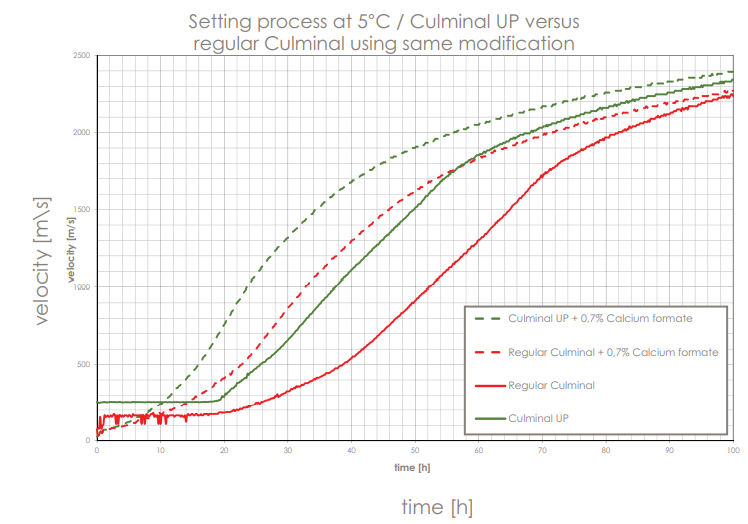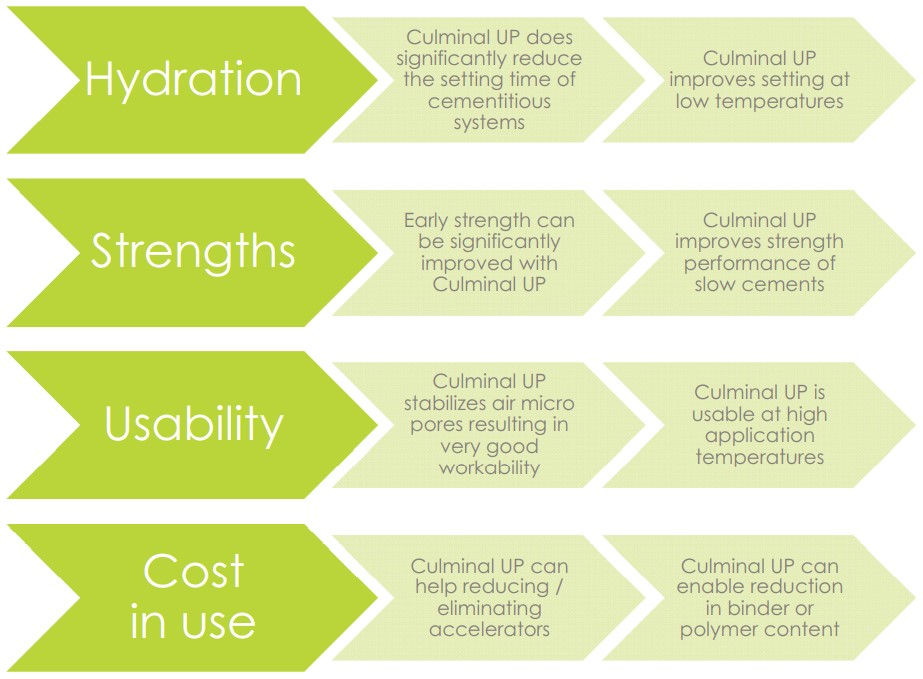culminal™ UP modified methylhydroxyethylcellulose
chemistry: cellulosics
culminal™ UP modified methylhydroxyethylcellulose for premium cementitious adhesives
Culminal™ UP (Ultimate Performance) modified methylhydroxyethylcellulose is a new concept of modified methyl cellulose derivatives used in premium cementitious adhesive formulations (e.g. tile adhesives, ETICS adhesives). There are a number of key performance gaps in today’s formulations, which are addressed with the Culminal™ UP modified methylhydroxyethylcellulose concept such as:
- faster strength development
- higher final tensile strength
- excellent workability & sag resistance
- improved setting at low temperatures
- cost savings due to reduction / elimination of accelerators and opportunity to reformulate towards different binder types (e.g. CEM II) and/or levels
culminal™ UP offers improved strength development
minimal impact on cement hydration
Many commonly used additives such as cellulose ethers, redispersible polymer powders, starch ethers and other functional additives have a negative impact on the setting profile of ordinary portland cement-based systems.
Furthermore, the use of composite cements is growing due to their lower carbon dioxide footprint (CEM II, CEM III). This trend can also negatively impact strength development.
Culminal™ UP modified methylhydroxyethylcellulose has been developed with one aim: to have as little impact on cement hydration as possible, ensuring high early and final tensile strength values while still providing excellent sag resistance and workability. To achieve this Ashland uses a new methylcellulose chemistry, which is optimized to achieve the ultimate performance.

reduction or elimination of set accelerators
To overcome the negative effects described earlier many formulations are accelerated e.g. with calcium formate. This adds another costly component into formulations.
Ashland has proven that significant reduction or elimination of accelerators can be achieved using culminal™ UP modified methylhydroxyethylcellulose instead of regular modified methyl cellulose derivatives. This leads to simplification of formulations and can result in significant overall formulation cost savings.
The graph shows 4 formulations comparing culminal™ with culminal™ UP with and without accelerator in the same formulation. As can be seen regular culminal™ shows the slowest setting and culminal™ UP leads to the fastest strength development. The curves of culminal™ UP shows almost the same strength development as regular culminal™ with additional use of calcium formate as accelerator.
The choice of a different type of modified methylhydroxyethylcellulose can lead to drastic reduction of setting time, in this example by ca. 50%. The absolute setting time values depend on cement quality and overall formulation design.

comparison of different modified methylhydroxyethylcellulose chemistries in light weight CTA at 5°C

Early and final strengths development in CTA is significantly improved by using Culminal™ UP modified methylhydroxyethylcellulose. This offers room for cement or RDP reduction or use of lower cost cement (CEM II, CEM III).
strength development at lower temperatures
As the speed of cement hydration is also impacted by temperature, many formulations become very “slow” in colder conditions. Using Culminal™ UP faster strength development can be achieved at lower temperatures when compared to regular modified cellulose ethers used today.
key benefits:
- faster strength development
- highly efficient in cold climates
- higher final tensile strength
- overall formulation cost saving potential. Elimination of accelerator using Culminal UP modified methylhydroxyethylcellulose has led to 2-4% cost saving without impact on final product properties.
advantages of culminal™ UP modified methylhydroxyethylcellulose

available culminal™ UP grades
- culminal™ UP 1530
- culminal™ UP 1540
- culminal™ UP 1560
- culminal™ UP 3010
read more >
additional content coming soon
additional content coming soon
additional content coming soon
additional content coming soon






